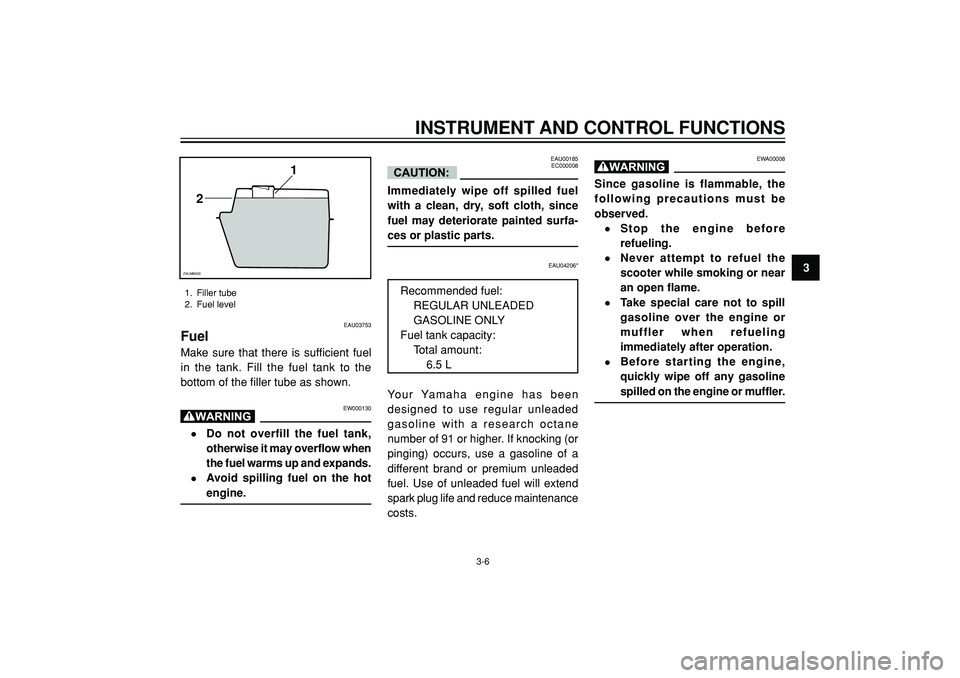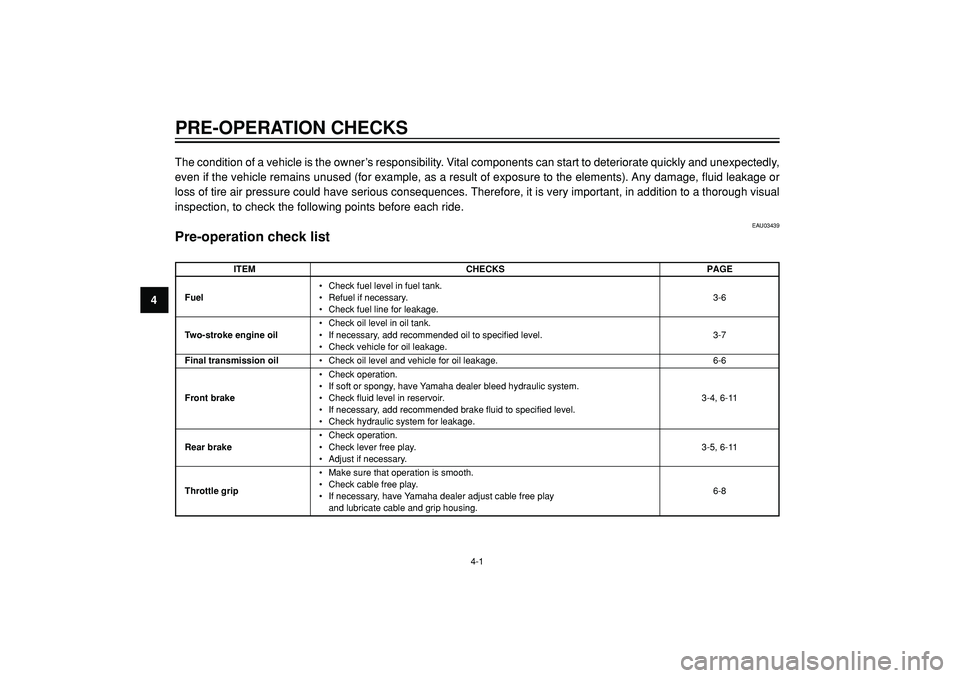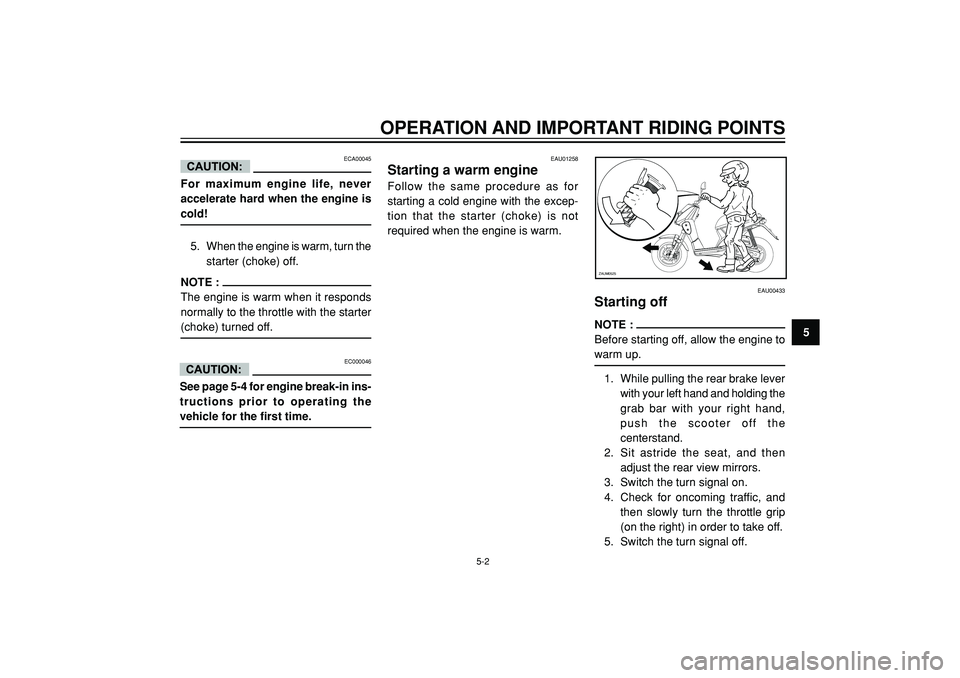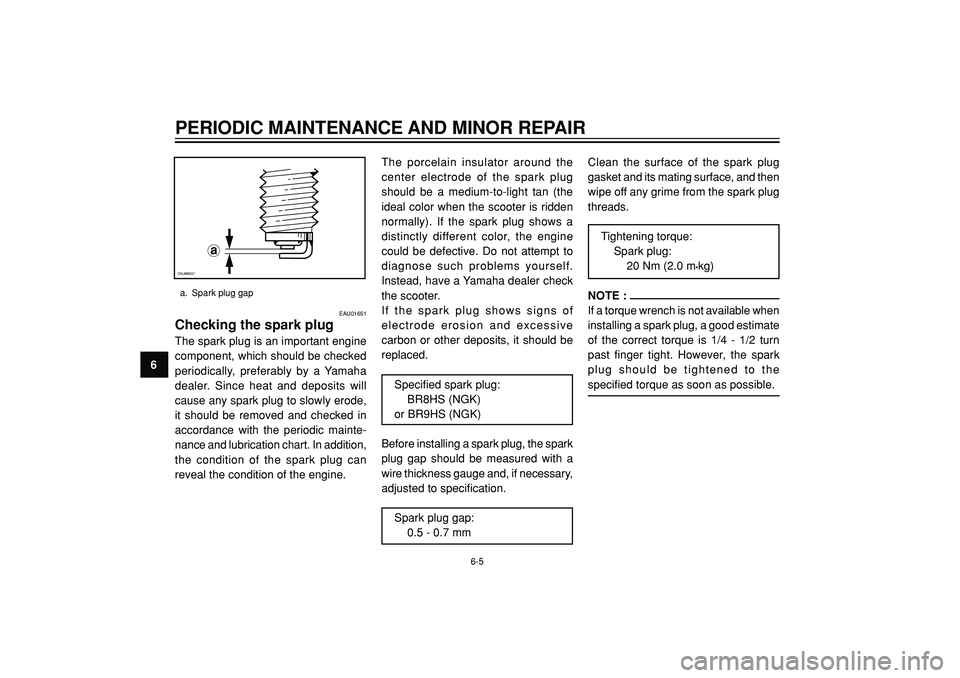ESP YAMAHA SLIDER 50 2005 Owners Manual
[x] Cancel search | Manufacturer: YAMAHA, Model Year: 2005, Model line: SLIDER 50, Model: YAMAHA SLIDER 50 2005Pages: 80, PDF Size: 2.06 MB
Page 23 of 80

INSTRUMENT AND CONTROL FUNCTIONS
3
1
2
ZAUM00201. Filler tube
2. Fuel level
EAU03753
FuelMake sure that there is sufficient fuel
in the tank. Fill the fuel tank to the
bottom of the filler tube as shown.
EW000130
•
Do not overfill the fuel tank,
otherwise it may overflow when
the fuel warms up and expands.
•
Avoid spilling fuel on the hotengine.
EAU04206*
Recommended fuel:
REGULAR UNLEADED
GASOLINE ONLY
Fuel tank capacity:
Total amount:
6.5 L
Your Yamaha engine has been
designed to use regular unleaded
gasoline with a research octane
number of 91 or higher. If knocking (or
pinging) occurs, use a gasoline of a
different brand or premium unleaded
fuel. Use of unleaded fuel will extend
spark plug life and reduce maintenance
costs.
EWA00008
Since gasoline is flammable, the
following precautions must be
observed.•
Stop the engine before
refueling.
•
Never attempt to refuel the
scooter while smoking or near
an open flame.
•
Take special care not to spill
gasoline over the engine or
muffler when refueling
immediately after operation.
•
Before starting the engine,
quickly wipe off any gasolinespilled on the engine or muffler.
3-6
EAU00185
EC000008
Immediately wipe off spilled fuel
with a clean, dry, soft cloth, since
fuel may deteriorate painted surfa-ces or plastic parts.
Page 28 of 80

PRE-OPERATION CHECKS
4The condition of a vehicle is the owner’s responsibility. Vital components can start to deteriorate quickly and unexpectedly,
even if the vehicle remains unused (for example, as a result of exposure to the elements). Any damage, fluid leakage or
loss of tire air pressure could have serious consequences. Therefore, it is very important, in addition to a thorough visual
inspection, to check the following points before each ride.
ITEM CHECKS PAGE
•Check fuel level in fuel tank.
Fuel•Refuel if necessary.3-6•Check fuel line for leakage.
•Check oil level in oil tank.
Two-stroke engine oil•If necessary, add recommended oil to specified level. 3-7•Check vehicle for oil leakage.
Final transmission oil•Check oil level and vehicle for oil leakage. 6-6
•Check operation.
•If soft or spongy, have Yamaha dealer bleed hydraulic system.
Front brake•Check fluid level in reservoir. 3-4, 6-11
•If necessary, add recommended brake fluid to specified level.
•Check hydraulic system for leakage.
•Check operation.
Rear brake•Check lever free play. 3-5, 6-11•Adjust if necessary.
•Make sure that operation is smooth.
Throttle grip•Check cable free play.
6-8
•If necessary, have Yamaha dealer adjust cable free playand lubricate cable and grip housing.
EAU03439
Pre-operation check list
4-1
Page 33 of 80

OPERATION AND IMPORTANT RIDING POINTS
5
ZAUM0525
EAU00433
Starting offNOTE :
Before starting off, allow the engine towarm up.
1. While pulling the rear brake lever
with your left hand and holding the
grab bar with your right hand,
push the scooter off the
centerstand.
2. Sit astride the seat, and then
adjust the rear view mirrors.
3. Switch the turn signal on.
4. Check for oncoming traffic, and
then slowly turn the throttle grip
(on the right) in order to take off.
5. Switch the turn signal off.
EAU01258
Starting a warm engineFollow the same procedure as for
starting a cold engine with the excep-
tion that the starter (choke) is not
required when the engine is warm.
ECA00045
For maximum engine life, never
accelerate hard when the engine iscold!
5. When the engine is warm, turn the
starter (choke) off.NOTE :
The engine is warm when it responds
normally to the throttle with the starter(choke) turned off.
5-2
EC000046
See page 5-4 for engine break-in ins-
tructions prior to operating thevehicle for the first time.
Page 34 of 80

OPERATION AND IMPORTANT RIDING POINTS
5
EAU00434
Acceleration and
decelerationThe speed can be adjusted by opening
and closing the throttle. To increase the
speed, turn the throttle grip in direction
a . To reduce the speed, turn the
throttle grip in direction b .
a b
ZAUM0199
cdds
ZAUM0526
EAU00435
Braking1. Close the throttle completely.
2. Apply both front and rear brakes
simultaneously while gradually
increasing the pressure.
EW000057
•
Avoid braking hard or suddenly
(especially when leaning over
to one side), otherwise the
scooter may skid or overturn.
•
Railroad crossings, streetcar
rails, iron plates on road cons-
truction sites, and manhole
covers become extremely
slippery when wet. Therefore,
slow down when approaching
such areas and cross them with
caution.
•
Keep in mind that braking on a
wet road is much more difficult.
•
Ride slowly down a hill, as
braking downhill can be verydifficult.
5-3
Page 42 of 80

PERIODIC MAINTENANCE AND MINOR REPAIR
6
EAU01651
Checking the spark plugThe spark plug is an important engine
component, which should be checked
periodically, preferably by a Yamaha
dealer. Since heat and deposits will
cause any spark plug to slowly erode,
it should be removed and checked in
accordance with the periodic mainte-
nance and lubrication chart. In addition,
the condition of the spark plug can
reveal the condition of the engine.The porcelain insulator around the
center electrode of the spark plug
should be a medium-to-light tan (the
ideal color when the scooter is ridden
normally). If the spark plug shows a
distinctly different color, the engine
could be defective. Do not attempt to
diagnose such problems yourself.
Instead, have a Yamaha dealer check
the scooter.
If the spark plug shows signs of
electrode erosion and excessive
carbon or other deposits, it should be
replaced.
Specified spark plug:
BR8HS (NGK)
or BR9HS (NGK)
Before installing a spark plug, the spark
plug gap should be measured with a
wire thickness gauge and, if necessary,
adjusted to specification.
Spark plug gap:
0.5 - 0.7 mmClean the surface of the spark plug
gasket and its mating surface, and then
wipe off any grime from the spark plug
threads.
Tightening torque:
Spark plug:
20 Nm (2.0 m
•kg)
NOTE :
If a torque wrench is not available when
installing a spark plug, a good estimate
of the correct torque is 1/4 - 1/2 turn
past finger tight. However, the spark
plug should be tightened to thespecified torque as soon as possible.
a
ZAUM0037a. Spark plug gap
6-5
Page 62 of 80

SCOOTER CARE AND STORAGE
7
CareWhile the open design of a scooter
reveals the attractiveness of the
technology, it also makes it more
vulnerable. Rust and corrosion can
develop even if high-quality
components are used. A rusty exhaust
pipe may go unnoticed on a car,
however, it detracts from the overall
appearance of a scooter. Frequent and
proper care does not only comply with
the terms of the warranty, but it will also
keep your scooter looking good, extend
its life and optimize its performance.Before cleaning
1. Cover the muffler outlet with a
plastic bag after the engine has
cooled down.
2. Make sure that all caps and
covers as well as all electrical
couplers and connectors,
including the spark plug cap, are
tightly installed.
3. Remove extremely stubborn dirt,
like oil burnt onto the crankcase,
with a degreasing agent and a
brush, but never apply such
products onto seals, gaskets and
wheel axles. Always rinse the dirt
and degreaser off with water.Cleaning
ECA00011
•
Avoid using strong acidic wheel
cleaners, especially on spoked
wheels. If such products are used
on hard-to-remove dirt, do not
leave the cleaner on the affected
area any longer than instructed.
Also, thoroughly rinse the area off
with water, immediately dry it, and
then apply a corrosion protection
spray.
•
Improper cleaning can damage
windshields, cowlings, panels
and other plastic parts. Use only
a soft, clean cloth or sponge with
mild detergent and water to clean
plastic.
•
Do not use any harsh chemical
products on plastic parts. Be sure
to avoid using cloths or sponges
which have been in contact with
strong or abrasive cleaning
products, solvent or thinner, fuel
(gasoline), rust removers or
inhibitors, brake fluid, antifreeze
or electrolyte.
7-1